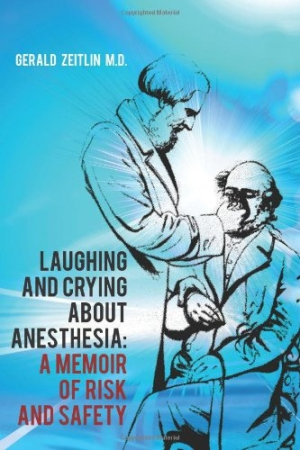Laughing and Crying about Anesthesia
A Memoir of Risk and Safety
In Laughing and Crying About Anesthesia: A Memoir of Risk and Safety, Dr. Gerald Zeitlin, an anesthesiologist for over fifty years, writes a wryly amusing history about this branch of modern medicine. Zeitlin began his studies in England in the late 1950s when anesthesia was just emerging as a medical specialty, and he moved soon after to the US to set up practice. Zeitlin gives an interesting first-hand account of the rapid changes in the ways physicians learned to manage pain, respiration, and heart rate during surgery. He also offers illuminating comparisons between the British and American medical systems as well as other aspects of both cultures, from doctor training to the prevalence of firearms.
Though Dr. Zeitlin has successfully put thousands of people to sleep during their surgical procedures, he will not do so to the readers of this book. Laughing and Crying About Anesthesia is dotted with anecdotes about Zeitlin’s childhood in London, part of which occurred during the Blitz, as well as many tales about quirky medical staff. There was the dashing Mr. Embry, a brilliant surgical assistant with a luxuriant waxed mustache who trained many a budding anesthesiologist—the author included—during the heat of surgery. Then there was Zeitlin’s brief interrogation about why he wanted to become an anesthesiology resident; the interview was conducted by a nude Dr. Robert MacIntosh, a legendary pioneer in anesthesiology and inventor of the laryngoscope.
Popular Science fans will be interested to read how the author and his associates successfully improvised certain techniques during tricky surgeries, and they will agonize along with the medical team when some of the techniques fail. Zeitlin consistently explains medical jargon so that the reading audience is not limited to medical professionals.
Zeitlin’s narrative is also full of dramatic historical asides (Winston Churchill’s experiences with anesthesia, for instance), tales of encounters with notable patients (an empathetic session with the author Robert Ruark, dying from cirrhosis), witty bits of poetry, and imaginatively remembered dialogue from hospital halls.
The author’s humor, often self-deprecating, enlivens every chapter. One learns about his musical preferences in the operating theatre and that trichlorethylene, an anesthetic commonly used in the 1950s, is splendid for removing borscht stains from a white shirt. The author endears himself to the reader with not only his other clever turns of phrase but also with his heartfelt mourning when he and his colleagues watch patients worsen and die.
Where Dr. Zeitlin’s memoir is less successful is in the rhythm and flow of his writing style. There is a choppiness throughout that makes it confusing as to which era, continent, or bit of anesthesia history is being discussed. Paragraphs in a certain time frame end, and new paragraphs jump in about a completely different patient or a historical tangent that is seemingly unconnected. Introducing new material or asides in a more seamless way would improve the flow immensely.
Several mentions of the specific Internet sites from which the author bought various medical books seem superfluous. There are also a few jarring moments in the text caused by spelling and grammatical mistakes.
This book will not only appeal to Popular Science readers, but would be an excellent informal introduction to anesthesiology for prospective medical students. The author discusses the unique challenges faced by anesthesiologists, from the irregularity of working hours to the great weight of responsibility in controlling a patient’s fate as he hovers between consciousness and death. As Zeitlin notes, the paradox of anesthesia is that it is either a very boring scenario (when it is successful) or too exciting (as when a patient’s vital signs suddenly crash), and as his title suggests, readers will laugh and cry along with him as they read this book.
Reviewed by
Rachel Jagareski
Disclosure: This article is not an endorsement, but a review. The publisher of this book provided free copies of the book and paid a small fee to have their book reviewed by a professional reviewer. Foreword Reviews and Clarion Reviews make no guarantee that the publisher will receive a positive review. Foreword Magazine, Inc. is disclosing this in accordance with the Federal Trade Commission’s 16 CFR, Part 255.

